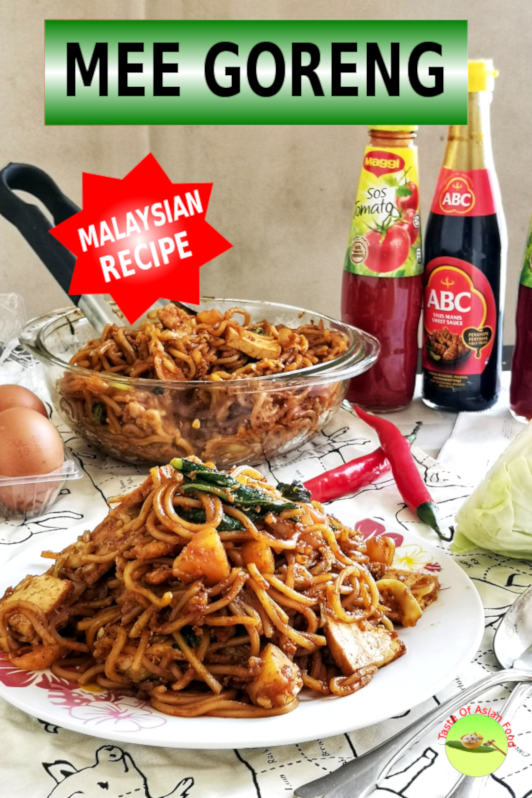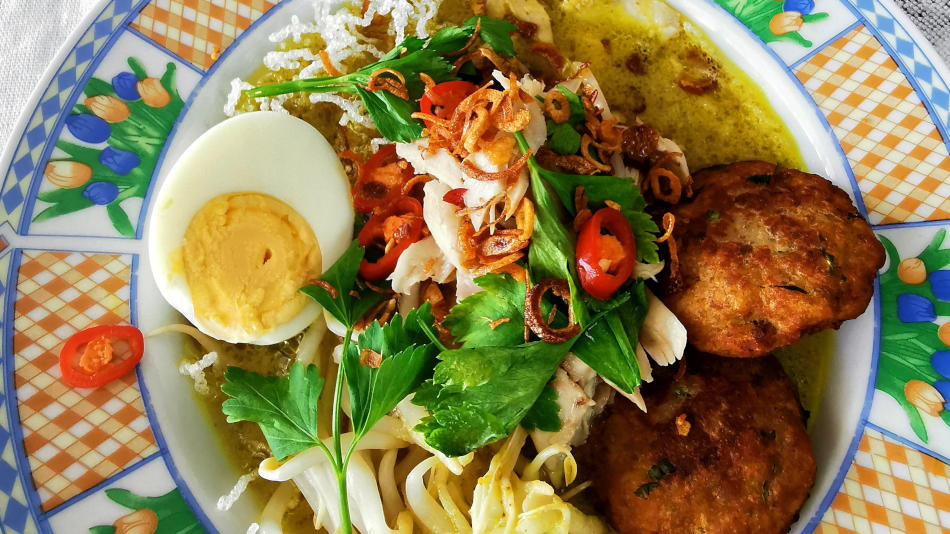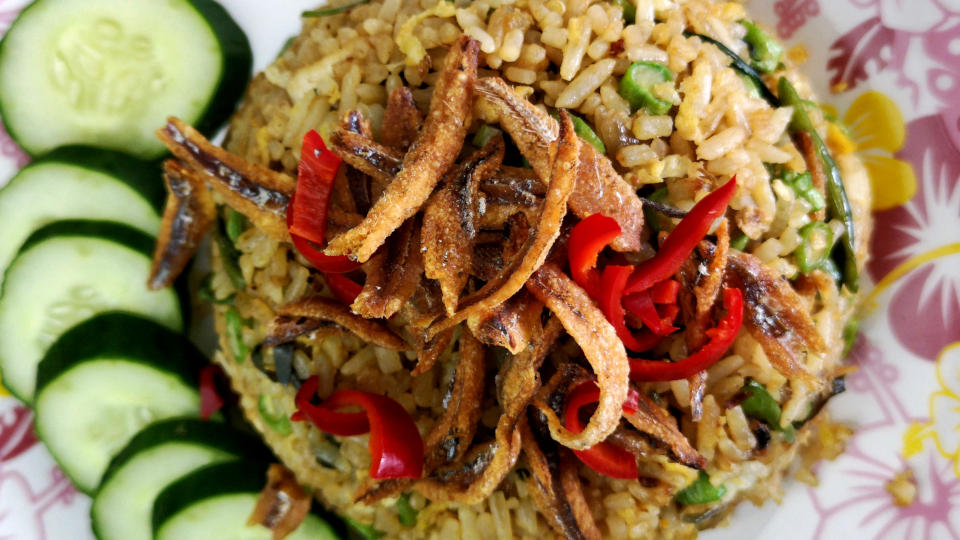Today, I would like to introduce you to Mee Goreng Mamak, a delightful stir-fried noodle dish with deep cultural roots in Indian Muslim heritage, particularly in Malaysia.
The term “Mee” refers to noodles, while “goreng” means stir-fried in both Malay and Indonesian languages.
Mee Goreng (also spelled as mi goreng) is distinctly different from Chinese dishes like Chow Mien and Malaysian Char Kuey Teow, primarily due to the unique ingredients and spices used.
Fresh yellow noodles are the most commonly used, although dried instant noodles can also be utilized. While Chinese egg noodles or rice noodles can serve as substitutes, they are not traditionally used in Mee Goreng preparation.
This dish has become a staple in Mamak shops and among Indian Muslim street vendors, with every eatery serving it as a must-try dish. It is a beloved street food that locals are familiar with.
This recipe reflects the traditional cooking style of Indian Muslims in Malaysia. While you may find variations of Mee Goreng from different regions, they all share the same terminology, meaning fried noodles.

Note: This post may contain affiliate links. Please read my privacy policy for more information. I may receive commissions for purchases made through links in this post.
A. Characteristics of Mee Goreng Mamak in Malaysia
Let’s explore the unique features of this dish. Tofu and potatoes are essential ingredients in Mee Goreng. Additionally, ketchup is a crucial component. The dish is known for its spiciness, enhanced by chili sauce and a sautéed chili paste called sambal.
Restaurants typically prepare it with curry and potatoes. To simplify the process, we will use curry powder and boil some potatoes separately, which can be found in most Asian grocery stores.
For a delicious chicken curry with potatoes, consider using this easy Malaysian-style recipe instead of the curry powder and boiled potatoes in your Mee Goreng.
While many restaurants serve it as a meatless dish, you can personalize your recipe by adding shrimp, squid, or meat.
Note: Mee Goreng is also referred to as mie goreng in some recipes.
B. Step-by-Step Guide to Preparing Mee Goreng Mamak
1. Blanch the Noodles
Fresh yellow noodles should be blanched in hot water for a few seconds until they loosen. Once they no longer stick together, drain and set aside. Since these noodles are pre-cooked, the blanching time is minimal, making it easier to fry them without sticking. Fresh egg noodles can be used as an alternative.
2. Prepare the Ingredients
Here are the essential ingredients for this Mee Goreng Mamak recipe:
- Cabbage adds a crunchy contrast to the soft noodles and should be cut into thin strips to reduce cooking time.
- Firm tofu is preferred; if using regular tofu, it should be deep-fried or pan-fried until firm to prevent it from breaking during stir-frying.
- Common protein additions include shrimp, squid, or chicken. For a vegetarian option, simply omit the meat.
- Cucur udang (prawn fritters) are often included, but we will skip this in our home recipe.
- Potatoes are essential; boil some wedges in advance to mimic the traditional method of using potatoes from curry.
- Consider preparing crispy shallots for topping and sliced green onions to add at the final cooking stage.
3. Prepare the Sauce
The seasonings for Mee Goreng differ significantly from those used in Chinese, Vietnamese, and Japanese noodles. Kecap Manis (sweet soy sauce) is a must-have ingredient, providing a unique flavor that cannot be replaced with other soy sauces. If unavailable, light soy sauce, dark soy sauce, and a bit of sugar can be used as a substitute.
Ketchup should not be replaced with tomato paste or fresh tomatoes, as it would alter the dish’s flavor.
Chili sauce is essential for the traditional recipe, but feel free to adjust the spiciness to your preference. Locals often enhance the heat with sambal oelek (local sautéed chili paste) and chopped bird’s eye chilies.
Other common seasonings include oyster sauce, which adds extra flavor. Combine all the seasoning ingredients in a bowl, adding some water to dilute for easier pouring during stir-frying. While you can add each ingredient separately, mixing them beforehand helps avoid omissions or doubling up on ingredients.

4. Tips Before You Start
Once you have prepared the sauce and all the ingredients, you can have this dish on the table in under five minutes. Stir-frying is one of the quickest cooking methods!
- Use a good wok. A well-seasoned large wok is ideal to prevent sticking. Alternatively, a large non-stick pan or skillet can be used since it doesn’t require extremely high heat.
- Cut the stems of choy sum into one-centimeter sections and stir-fry them with the cabbage for a minute or two before adding the leafy parts, as the stems take longer to cook.
- Indian Muslims often enjoy spicy food. While I have omitted some spicy ingredients for this recipe, using bottled chili sauce is essential for a hint of authentic flavor.
- Always add the eggs last, scrambling them into small pieces. They should be nearly cooked before folding into the noodles to coat them partially and combine with the sauce.
- For an extra flavor dimension, squeeze some fresh lime juice over the dish just before serving. (Optional)
- The order of ingredient addition is flexible, but vegetables should go first, and eggs last. The key is to ensure the sauce evenly coats the noodles. Add water if the sauce is too dry.
- Since noodles and eggs can stick easily, use medium-high heat for stir-frying. The flavor comes from the combination of seasonings and ingredients, so high heat is less critical for Mee Goreng Mamak.
Related Recipes to This Easy Mee Goreng Recipe
If you enjoy this Mee Goreng recipe, you may also want to try other popular Malaysian and Indonesian noodle dishes:
- Soto Ayam is a renowned chicken soup dish from Indonesia, featuring a clear broth with a variety of ingredients and condiments.
- Ipoh Hor Fun is a soup noodle dish made with an exotic broth created from chicken bones and shrimp shells, topped with shredded chicken.
- Siam Road Char Kuey Teow from Penang has earned a spot on the World Street Food Top 50 list, featuring a mix of Chinese sausage, cockles, and a delightful wok aroma.
Ingredients
Sauce (A)
Others (B)
- 450g yellow noodles
- 3 tbsp cooking oil
- 3 cloves garlic, coarsely chopped
- 1 small onion (70g), thinly sliced
- 75g chicken breast meat, cut into thin slices
- 150g choy sum
- 100g cabbage, thinly sliced
- 150g firm tofu
- 1/2 tomato (50g), diced
- 1 small potato (70g), diced and boiled until soft
- Sambal and bird’s eye chili (to adjust spiciness)
- 3 eggs
- 1/2 teaspoon salt
- One lime for juice and decoration
Instructions
- Blanch the mee in boiling water for fifteen seconds. Drain and set aside.
- Combine all the ingredients in (A).
- Heat some vegetable oil in the wok. Sauté the onion and garlic until aromatic.
- Add the chicken breast meat and season with salt. Fry until cooked and slightly browned.
- Stir-fry the choy sum and cabbage with some oil, seasoning with salt. Add water if it becomes too dry.
- When the vegetables are soft, return the chicken to the wok. Add the tofu, tomatoes, potato slices, and the sauce (A). Then, incorporate the yellow noodles with all the ingredients in the wok.
- Add water if the mixture is too thick.
- Increase the heat to medium/high and stir-fry for a minute.
- Reduce the heat to low. Push the noodles to one side of the wok, add more oil, and crack the eggs onto it.
- Spread the eggs with a spatula and slowly fold them into the noodles. Continuous stirring and flipping are necessary as it will be sticky.
- Remove from heat and serve with lime wedges.
Recommended Products
As an Amazon Associate and member of other affiliate programs, I earn from qualifying purchases.
Nutrition Information:
Yield: 3
Serving Size: 3 servings
Amount Per Serving:
Calories: 877
Total Fat: 37g
Saturated Fat: 7g
Trans Fat: 0g
Unsaturated Fat: 24g
Cholesterol: 243mg
Sodium: 1890mg
Carbohydrates: 94g
Fiber: 10g
Sugar: 21g
Protein: 45g
This data was provided and calculated by Nutritionix on 8/12/2019





